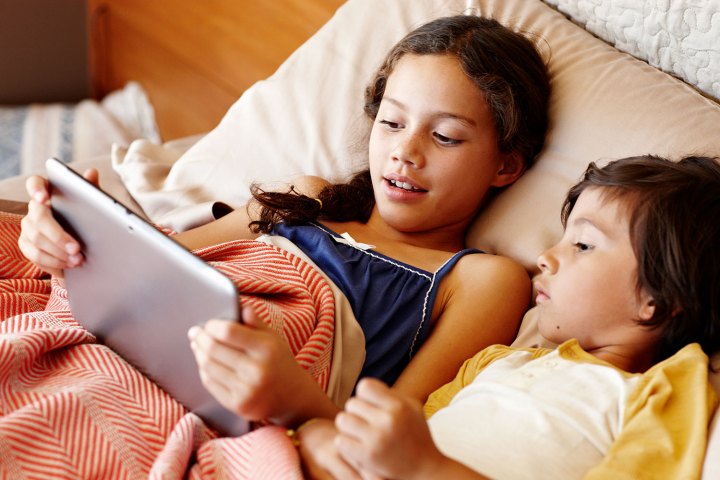
Our children are learning to use them for everything, too. In the UK, kids aged between 5 and 16 spend an average of 6.5 hours per day in front of a screen, according to the Connected Kids report from Childwise. In the United States, it’s a similar story, with children between the ages of 8 and 18 averaging around 7 hours per day with some form of media, according to the Kaiser Family Foundation.
One hour of TV viewing per day for kids can shorten sleep by seven minutes per day.
The American Academy of Pediatrics (AAP) recommends that entertainment screen time is limited to one or two hours per day, and that children under two years of age don’t watch any at all.
“That recommendation came out 25 years ago, and it was based on an obesity study,” explained Dr. Victor Strasburger, the policy statement’s lead author and a professor of pediatrics at the University of New Mexico. “Since that time, we’ve seen the rise of iPads and cell phones and Internet access for all.”
The two hour recommendation hasn’t changed, but kids today are spending more time than ever with screens and using them for more activities. A concern that was initially primarily about the physical risks of being sedentary in front of the TV for hours, has now grown to include the potential mental impact of exposure to certain media on all those screens.
What are the possible negative effects?
It’s long been an accepted wisdom that too much time spent sitting in front of the TV is bad for us. It may not lead to square eyes, as our mothers told us, but it is strongly linked to obesity in adults and children. TV viewing has also been linked with disruptions to sleep; one hour of TV viewing per day for kids can shorten sleep by seven minutes per day, according to this study.
For babies and toddlers under the age of two, there’s strong evidence that screen viewing has a negative effect on language development. There’s also no evidence that educational media, which may provide benefits for older kids, works for children under two.
Exposure to the wrong kinds of media could also be contributing to aggressive behavior, substance abuse, early sexual activity, and eating disorders. Children and young adults are much more likely to be influenced by media than older adults.
“We can make reasoned decisions, which adolescents can’t always do,” explains Dr. Strasburger. “The last part of your brain to develop deals with judgment, decision-making, and impulse control and it doesn’t fully mature until around the age of 25.”
I grew up in front of a TV, and I’m fine
A lot of parents will make the argument that they watched hours of TV every day growing up and turned out fine, but content and access has changed. There’s a world of difference between Playboy and modern Internet pornography. Kids today can potentially see whatever they want, whenever they want. Sex and violence are more prevalent in our media today than they’ve ever been.
There’s plenty of good content out there, but you can’t trust that your kids will find it.
“Parents have a responsibility to monitor the content their children are exposed to, but many parents are clueless,” says Dr. Strasburger. “Violent and sexual content is not healthy for kids.”
There’s plenty of good content out there, but you can’t trust that your kids will find it. Dr. Strasburger is quick to point out that entertainment and media are not inherently harmful. Sesame Street, for example, is lauded for helping teach kids letters and numbers. It’s not necessarily screen time itself that’s the problem, but rather the content that’s being consumed and the environment it’s being consumed in.
“It does make a difference if they watch with peers, some of the comments they make may be very important,” Dr. Strasburger explains. “Watching with parents can be good too, but only if they talk about what’s happening onscreen, just being in the same room is not enough.”
The research suggests that positive parental influences will still outweigh the media. The wrong videogame, music, or movie is not going to turn a good kid bad, but a constant stream of sex and violence for a prolonged period could have an impact. If you do watch something violent with your children, make sure that you discuss it and that they understand violence isn’t okay.
How do you limit screen time?
When you factor in school, playing, clubs, and meals, it really shouldn’t be too difficult to shoot for that two hour limit on an average week day, but weekends are a different matter. The AAP suggests that keeping TVs and other devices out of kid’s bedrooms is a really important step. If it’s in their bedroom, they’ll use it more, and without supervision, they’re more likely to access things they shouldn’t.
It’s also vitally important to take an interest in what they’re watching or playing. Parents have to impose a few restrictions and maintain some control over the type and amount of media their kids are accessing.
There’s no doubt that it’s tough to restrict screen time for children in the modern world, particularly when many of us adults are spending so much time with screens ourselves, but it’s something you need to think about early. Changing older kids’ habits isn’t easy.
“If you have a teen who plays first-person shooters five hours a day, then good luck,” says Dr. Strasburger. “You really have to start from the beginning. If you limit screen time from an early age, then your kids will get into healthy habits.”
Editors' Recommendations
- Why kids are getting addicted to digital media
- Is cell phone radiation actually dangerous? We asked some experts
- What is UFS 3.0 storage? We asked an expert about the SSD for phones



